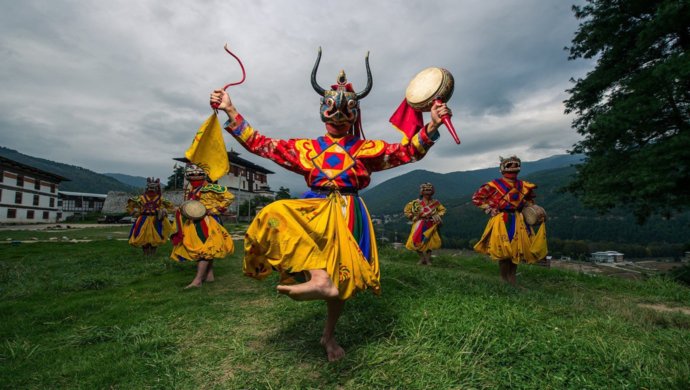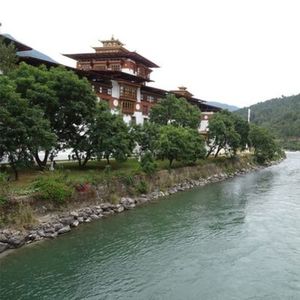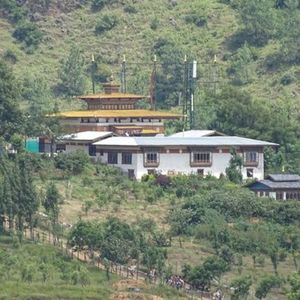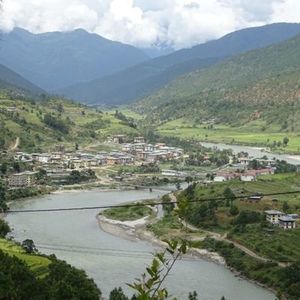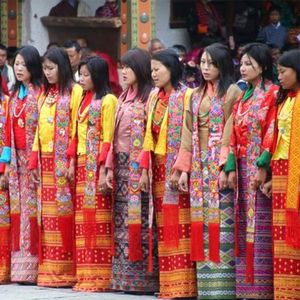Day 1. Paro - Thimphu:
Driving Distance: 65 Kms, Driving time: 1.50 hrs - 2 hrs, Altitude of Thimphu: 2,350 m
Your flight to Paro on a clear day, is marked with the panoramic views of the Himalayas including the Everest and other famous Peaks. The approach through the foothills and the landing (including few steep turns) at the tiny airstrip of Paro has been termed as adventurous by many travelers. After the completion of immigration formalities at the Paro Airport exit door, you will be received by your Bhutanese guide with traditional “Tashi Khadar”. Afterwards drive to Thimphu following the Pa Chhu River. Check-In to the hotel and have your first experience with Bhutanese Cuisine. Later visit,
- Tashichhodzong, or ‘the fortress of the glorious religion’. Initially erected in 1641 by Shabdrung Ngawang Namgyal, it was rebuilt in the 1960s during the reign of Bhutan’s third king in the traditional style, without plans or nails. It houses some ministries, His Majesty’s secretariat, and the central monk body and opens after 5 PM.
Rest of the day is at leisure. You can explore the Thimphu valley and town or shop till your heart’s content.
Meals – Lunch and Dinner; Overnight at the Hotel in Thimphu.
Day 2. Thimphu Sightseeing - Punakha/Wangdu:
Driving Distance: 76 Kms, Driving time: 2.50 hrs - 3 hrs, Altitude of Punakha: 1310 m
Today you would be driven in and around Thimphu covering key places of interest. After breakfast you would visit
- Kuensel Phodrang, the gigantic Buddha Dordenma Statue located atop a hill in Kuensel Phodrang Nature Park.
- National Memorial Chhorten, a Stupa built in 1974 to honor the third Druk Gyalpo, Jigme Dorji Wangchuck. Every morning till night old people and young people circumambulate the Chhorten.
- Sangaygang View Point, also known as BBS Tower offering panoramic view of Thimphu Town situated at an elevation of 2,685 m.
- Changangkha Monastery, popular fortress like temple perched on a ridge above Central Thimphu built in 15th Century by Lama Phajo Drugom Zhipo.
- Takin Preserve Centre, see Takin (National animal of Bhutan) It is a unique combination of Goat and an Antelope
After lunch, you would check out of the hotel and get driven to Punakha / Wangdue. On the way stop at:
- Dochula Pass, lies at an elevation of 3,150 m and is a great place to view the higher Himalayas. The landmarks around the pass includes 108 Druk Wangyal Stupas built under the patronage of Queen Ashi Dorji Wangmo Wangchuk.
On arrival in Punakha / Wangdue, you complete your check in formalities. Rest of the evening free for leisure.
Meals – Breakfast, Lunch and Dinner; Overnight at the Hotel in Punakha/Wangdue.
Day 3. Punakha/Wangdue Sightseeing:
Festival Day 2
After Breakfast, you would visit
- Punakha Dzong, built in 1637 by Shabdrung Ngawang Namgyal. For many years until the time of the second King, it served as the seat of the Government. It is still the winter residence of Je-Khenpo (The Chief Abbot of the Central Monastic Body of Bhutan)
Here you would enjoy the day 2 of the festival.
- Day 2 – You would notice that the dances are performed by both monks and laymen according to steps meticulously choreographed by Buddhist masters in the past. These steps are filled with religious symbols that it will not be easy for Non-Bhutanese people to understand without guide’s help. You would also hear folk songs performed on the occasion.
The Tshechu dances must be understood at three levels:
- At the visual level as it is happening on the ground
- It is believed that observing the festival bestows merit on the persons
- Also as per the legends watching all these compassionate and fearful deities in this life will give us understanding and courage to meet them, who will be there to assist us in our journey afterlife.
Apart from being a religious affair, Tshechu is also a social event. People gather at the local Dzong in their best Gho and Kira with packed lunches and make merry. You would see how may locals from far off places dressed in their finest clothes come to watch masked dances, to pray, to feast and to enjoy the atmosphere. Local people believe that everyone must attend a Tshechu and witness the mask dances at least once in their life in order to receive blessings and wash away their sins. In order the understand the festival, we would arrange a local monk who would explain the event in detail.
Lunch would be served at a local restaurant. After the end of the first day, you would be drive back to the hotel. Evening free for leisure.
Meals – Breakfast, Lunch and Dinner; Overnight at the Hotel in Punakha/Wangdue.
Day 4. Punakha/Wangdue Sightseeing:
Festival Day 3
Early in the morning before the sunrise, you would again be taken to to Punakha Dzong to enjoy the last day of the festival. You guide would let you know the exact time.
- Day 3 – Early in the morning, you would see the Thongdrol being unfurled from the main building overlooking the dance area and a Shugdrel ceremony performed. This is done before sunrise and most people rush to witness the moment as it is believed that our bad karma is expiated just by viewing it. Throngdels are large Thankas or scrolls usually embroidered rather than painted. Later you would witness the final day’s dances. Again there would a local monk who would explain the event in detail.
Lunch would be served at a local restaurant. After the final dance is performed and last song sung, you would be drive back to the hotel. Evening free for leisure.
Meals – Breakfast, Lunch and Dinner; Overnight at the Hotel in Punakha / Wangdue.
Day 5. Punakha/Wangdue - Gangtey/Phobjika:
Driving Distance: 78 kms, Driving time: 2.50 hrs - 3 hrs, Altitude of Gangtey/Phobjikha: 2900 m
After breakfast, visit the
- Chhimi Lhakhang, a famous Temple, which is also known as “The Temple of Fertility” built by Lama Drukpa Kuenley
Then, you would be driven to Gangtey / Phobjika. While in Gangtey, visit the
- Gangtey Goemba, an important monastery of Nyingmapa school of Buddhism, the main seat of the Pema Lingpa tradition. The present Abbot, Kunzang Pema Namgyal is the ninth re-incarnation. It is one of the the largest Nyingma monastery in Bhutan.
- Black Necked Crane Information Centre, a place for recreation with crane watching equipment (binoculars, spotting scopes) and reference books
Lunch would be provided at a local restaurant. After the completion of sightseeing, you are driven back to your hotel. After relaxing for sometime you are served with dinner.
Meals – Breakfast, Lunch and Dinner; Overnight at the Hotel in Phobjika/Gangtey.
Day 6. Gangtey / Phobjikha Valley - Punakha/Wangdue:
Driving Distance: 78 kms, Driving time: 2.50 hrs - 3 hrs, Altitude of Punakha: 1310 m
In the morning, you would explore the Phobjika Valley.
- Phobjikha Valley, one of the most beautiful glacial valleys in the Himalayas. It lies at an elevation of 3,000 m. It is surrounded by a large village inhabited mainly by the families of the 140 Gomchens who take care of the monastery. Phobjikha is best known for the rare black necked cranes that migrate here from the Tibetan Plateau to avoid the extremely cold winters.
You may choose to do any of the following: Visiting villages and interacting with People, Hikes around the valley, Photography, etc. After lunch, you would drive back to Punakha / Wangdue.
Meals – Breakfast, Lunch and Dinner; Overnight at the Hotel in Punakha/Wangdue.
Day 7. Punakha/Wangdue - Paro:
Driving Distance: 135 kms, Driving Time: 4 hrs - 5 hrs, Altitude of Paro: 2280 m
After Breakfast, you are driven to Paro. Post Lunch, visit
- Paro Rimpung Dzong, also known as Fortress of the heap of jewels, built during the time of Shabdrung Ngawang Namgyal in 1646.
- Ta Dzong, an ancient watch tower overlooking Rimpung Dzong built in 1951 now converted into national museum.
Evening free for leisure to walk around the streets of Paro.
Meals – Breakfast, Lunch and Dinner; Overnight at the Hotel in Paro.
Day 8. Paro Sightseeing:
After breakfast, start your day with a hike to:
- Taktsang Monastery (Tiger's nest), the abode of gods and monks situated at an altitude of 3100m on the Upper Paro Valley, Bhutan. As per the legend, Guru Padmasambhana (Guru Rinpoche), the tantrum mystic who brought Buddhism to Bhutan, came in the form of Dorje Droloe riding a flying tigress to subdue the demon that was obstructing the spread of Buddhism in the Himalayas.
After the completion of the hike, you would be served picnic Lunch among the woods. After lunch, visit
- Kyichu Lhakhang, one of the oldest monasteries in Bhutan built in the 7th century by the Tibetan Emperor Songtsen Gampo.
You would then drive to village house to witness the traditional rural life in a Bhutanese village. Also you have an option of experiencing a Traditional Hot Stone bath in the village house. You can also choose to have your dinner in the house with the Family or be driven back to your hotel.
Meals – Breakfast, Lunch and Dinner; Overnight at the Hotel in Paro.
Day 9. Departure:
Today we will bid farewell to this beautiful country and take an early flight back. We hope by now you mist have made some good friends and also have taken photographs and beautiful memories of Bhutan. We certainly hope of serving you again on your next visit to this great country or the Last Shangri-La. Tashi Delek.
